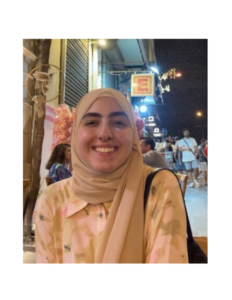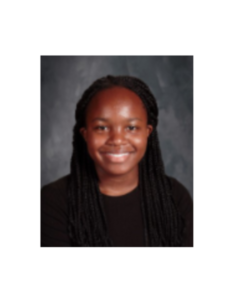Getting Out the Facts on Public Health
All-Girl Team Wins Junior Academy Challenge Combating Public Health Misinformation.
Collaborating across borders, U.S.-based student Angel and Asmaa from Jordan won New York Academy of Sciences’ Junior Academy Innovation Challenge with a text-based campaign designed to combat online misinformation and provide young people with accurate facts about public health issues. The two participants were part of an all-female STEM team that also included participants from Lebanon and Oman.
Angel, aged 15, who lives in upstate New York, and Asmaa, aged 16, based in Amman, Jordan, have never met in person– but the two high school students got to know each other well over an intense 10-week period in the spring.

Both passionate about science, the teenagers collaborated online, alongside other team members from Lebanon and Oman, to compete in New York Academy of Sciences’ Junior Academy Innovation Challenge, “Combating Misinformation about Public Health.” The Junior Academy is a virtual, international network of students aged 13-17 who have a deep interest in STEM and work together to solve society’s greatest challenges (“Innovation Challenges”).
For Angel and Asmaa, the experience has been uplifting– not only because their team, “Girls Combating Misinformation,” won the challenge (chosen among 11 teams that submitted final presentations).
“Being part of this challenge has definitely impacted me, in my coursework at school, in other areas in my life. I feel better getting my voice out. I have become more of a scientific thinker overall because you have to come up with a creative solution that attracts people and offers a different approach. I feel I have grown as a person through this project,” said Angel.

Empowering Girls in STEM
Both participants acknowledge that girls sometimes lack the confidence to study science, technology, engineering and mathematics (STEM) subjects.
“Girls may think they don’t have enough knowledge to get into STEM. Sometimes, the community places the bar too high, although this may not just affect girls,” said Asmaa.
Globally, women are still under-represented in STEM-related fields, both in education and as practitioners. On average, less than 30 percent of the world’s researchers are women.[1] In general, fewer women than men study life sciences, and the gender gap is even wider in fields like engineering and maths.
Diversity is important for the future of science, which is why the Junior Academy seeks to empower young women in STEM and to encourage them to consider careers in these fields. In 2021-2022, its programs had 63 percent female participation.
At the initial stage, the teammates, coming from diverse backgrounds, assessed each other’s strengths and abilities, communicating through the Junior Academy’s Launchpad online platform.
“We all had different interests coming in, then we started narrowing them down. It was very useful to have their insights, different perspectives. It really helped the project blossom,” said Angel.
She praised the team spirit that developed among the participants as they allocated tasks and responsibilities and started developing and testing their ideas.
Developing an Idea
Before coming up with their innovative approach against misinformation, the team researched how information on vaccines, cancer, tobacco, drugs, mental health, nutrition, and other health conditions is disseminated online. They immersed themselves in their assignment, meeting online every Saturday, reaching out to experts, and carrying out surveys among their peers to gain a better understanding of the problem.
“A lot of misinformation about health affects children and teens through social media,” reflected Asmaa, who said she boosted her research skills during the challenge. “When you start researching a topic, you want to get to the root of it.”
Eventually, the students opted to use text messages as the most impactful way to reach young people, and designed a campaign that would deliver daily, accurate facts on health issues, focusing particularly on correcting misleading information on topics trending on social media. To test their approach, they encouraged peers to sign up to receive these reliable health messages.
“We were stoked to have won the challenge,” said Angel, who suggested to her teammates that they continue working on the project and implement their concept. “We’ll do some outreach and tell the world about our solution.”
Angel and Asmaa said working as a team on this assignment has taught them a lot and strengthened their skills in communication, writing, leadership and problem solving.
“I feel that all of us have gained more confidence in ourselves, and we’ll push to end the STEM gender divide,” Angel says.
Inspired to Inspire
Having a supportive mentor who shared her own expertise and provided guidance and encouragement along the way contributed to their success, Asmaa pointed out. Asmaa believes role models are important, particularly for girls who may find STEM topics daunting.
She credits a charismatic science teacher at her school for kindling her own passion for maths and biology.
“I hope one day I will be able to inspire others to do what they want. To students interested in participating in a challenge, especially girls, I would say: It is a great experience. Don’t hesitate; just go for it. We all make mistakes and we learn from them. That’s how we grow,” said Asmaa.
For teenagers who have not found such inspiration at school, she believes that participating in the Junior Academy would be an exciting way to explore STEM fields.
Asmaa says her involvement in the project has made her more self-assured, and has reinforced her desire to study medicine. Angel, whose primary interests were psychology and the human mind, says the project has sparked her interest in a new field. “After this challenge on public health, I feel I want it to be part of my future,” she said.
The Junior Academy was supported by the Stevens Initiative, which is sponsored by the U.S. Department of State, with funding provided by the U.S. Government, and is administered by the Aspen Institute.
[1] UNESCO, Women in Science 2019
A version of this story was originally published on the Stevens Initiative’s website here.
Warning: Undefined variable $showit in /var/www/nyas_develop/nyas/public/wp-content/themes/nyas-theme-child/includes/shortcodes.php on line 1802
